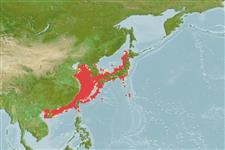>
Scombriformes (Mackerels) >
Scombridae (Mackerels, tunas, bonitos) > Scombrinae
Etymology: Scomberomorus: Latin, scomber = mackerel + Greek, moros = silly, stupid (Ref. 45335).
More on author: Cuvier.
Environment: milieu / climate zone / depth range / distribution range
Sinh thái học
Biển; Ở đại duơng, biển (Ref. 51243); Mức độ sâu 0 - 200 m (Ref. 54883). Temperate; 45°N - 18°N, 108°E - 143°E (Ref. 54883)
Northwest Pacific: confined to the subtropical and temperate waters of China, the Yellow Sea and Sea of Japan north to Vladivostok, former USSR. Often confused with Scomberomorus munroi.
Bộ gần gũi / Khối lượng (Trọng lượng) / Age
Maturity: Lm ? range ? - ? cm
Max length : 113 cm TL con đực/không giới tính; (Ref. 116934); Khối lượng cực đại được công bố: 8.0 kg (Ref. 116934)
Các tia vây lưng cứng (tổng cộng): 19 - 21; Các vây lưng mềm (tổng cộng): 15-19; Tia mềm vây hậu môn: 16 - 20; Động vật có xương sống: 48 - 50. Interpelvic process small and bifid. Lateral line gradually curving down toward caudal peduncle. The only species in the genus with a straight intestine. Swim bladder absent. Body covered with small scales. Anterior quarter of first dorsal fin and a narrow distal margin of the rest of the dorsal fin black. Sides with seven or more rows of longitudinal spots on the sides; some spots connected together.
Found near shore (including semi-enclosed sea areas) (Ref. 11230). Undergoes a spawning migration in spring (March to June) and a feeding migration in fall (September to November) in the Inland Sea of Japan. Feeds on small fishes. Another major fishing gear that is used are set nets. This species is the most important Scomberomorus species in Japan which is cultured and released for fishery. Marketed fresh and especially tasty in winter. Eaten pan-fried, broiled and baked (Ref. 9988).
Collette, B.B. and C.E. Nauen, 1983. FAO Species Catalogue. Vol. 2. Scombrids of the world. An annotated and illustrated catalogue of tunas, mackerels, bonitos and related species known to date. Rome: FAO. FAO Fish. Synop. 125(2):137 p. (Ref. 168)
IUCN Red List Status (Ref. 130435)
Threat to humans
Harmless
Human uses
Các nghề cá: tính thương mại cao; Nuôi trồng thủy sản: Tính thương mại; cá để chơi: đúng
Các công cụ
Special reports
Download XML
Các nguồn internet
Estimates based on models
Preferred temperature (Ref.
123201): 13 - 24.5, mean 19.2 °C (based on 181 cells).
Phylogenetic diversity index (Ref.
82804): PD
50 = 0.5000 [Uniqueness, from 0.5 = low to 2.0 = high].
Bayesian length-weight: a=0.00288 (0.00155 - 0.00538), b=3.15 (2.97 - 3.33), in cm total length, based on LWR estimates for this species & (Sub)family-body (Ref.
93245).
Mức dinh dưỡng (Ref.
69278): 4.5 ±0.8 se; based on diet studies.
Generation time: 2.1 ( na - na) years. Estimated as median ln(3)/K based on 2
growth studies.
Thích nghi nhanh (Ref.
120179): Trung bình, thời gian nhân đôi của chủng quần tối thiểu là 1.4 - 4.4 năm (K=0.7; Fec>100,000).
Prior r = 0.57, 95% CL = 0.37 - 0.85, Based on 1 stock assessment.
Fishing Vulnerability (Ref.
59153): Low to moderate vulnerability (34 of 100).
Climate Vulnerability (Ref.
125649): High vulnerability (58 of 100).
Nutrients (Ref.
124155): Calcium = 13.3 [4.9, 52.9] mg/100g; Iron = 0.325 [0.125, 0.917] mg/100g; Protein = 20.6 [19.1, 22.0] %; Omega3 = 0.47 [0.25, 0.94] g/100g; Selenium = 21.4 [6.2, 103.2] μg/100g; VitaminA = 8.35 [1.43, 54.86] μg/100g; Zinc = 0.31 [0.19, 0.53] mg/100g (wet weight); based on
nutrient studies.
